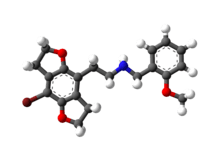2CBFly-NBOMe
2CBFly-NBOMe (NBOMe-2C-B-FLY, Cimbi-31) is a compound indirectly derived from the phenethylamine hallucinogen 2C-B, and related to benzodifurans like 2C-B-FLY and N-benzylphenethylamines like 25I-NBOMe. It was discovered in 2002,[1] and further researched by Ralf Heim at the Free University of Berlin,[2] and subsequently investigated in more detail by a team at Purdue University led by David E. Nichols.[3] It acts as a potent partial agonist for the 5HT2A serotonin receptor subtype.[4][5][6]
 | |
 | |
| Names | |
|---|---|
| Other names
N-(2-Methoxybenzyl)-1-(8-bromo-2,3,6,7-tetrahydrobenzo[1,2-b:4,5-b’]difuran-4-yl)-2-aminoethane | |
| Identifiers | |
CAS Number |
|
3D model (JSmol) |
|
| Abbreviations | 2CBFly-NBOMe |
| ChemSpider | |
PubChem CID |
|
CompTox Dashboard (EPA) |
|
InChI
| |
SMILES
| |
| Properties | |
Chemical formula |
C20H22BrNO3 |
| Molar mass | 404.298 g/mol |
Except where otherwise noted, data are given for materials in their standard state (at 25 °C [77 °F], 100 kPa). | |
| Infobox references | |
Analogues and derivatives
Analogues and derivatives of 2C-B:
- 2C-B-FLY
- 2CBFly-NBOMe (NBOMe-2CB-Fly)
Other:
- 2C-B-AN
- 2C-B-BUTTERFLY
- 2C-B-DragonFLY
- 2CB-5-hemifly
- 2CB-Ind
- βk-2C-B (beta-keto 2C-B)
- TCB-2 (2C-BCB)
Legality
United Kingdom
This substance is a Class A drug in the United Kingdom as a result of the N-benzylphenethylamine catch-all clause in the Misuse of Drugs Act 1971.[7]
United States
2CBFly-NBOMe is a controlled substance in Vermont as of January 2016.[8]
References
- Elz S; et al. (2002). "Development of highly potent partial agonists and chiral antagonists as tools for the study of 5-HT2A-receptor mediated function". Naunyn-Schmiedeberg's Archives of Pharmacology. 365 (1 Suppl): R21–R40. doi:10.1007/s00210-002-0604-4.
- Heim, Ralf (2004). Synthese und Pharmakologie potenter 5-HT2A-Rezeptoragonisten mit N-2-Methoxybenzyl-Partialstruktur. Entwicklung eines neuen Struktur-Wirkungskonzepts (PhD.). Free University of Berlin.
- Braden, Michael Robert (2007). Towards a biophysical understanding of hallucinogen action (PhD.). Purdue University. ProQuest 304838368.
- Silva ME; et al. (January 2011). "Theoretical studies on the interaction of partial agonists with the 5-HT(2A) receptor". Journal of Computer-aided Molecular Design. 25 (1): 51–66. CiteSeerX 10.1.1.688.2670. doi:10.1007/s10822-010-9400-2. PMID 21088982. Archived from the original on 2014-02-17. Retrieved 2018-07-24.
- Ettrup, A.; Hansen, M.; Santini, M. A.; Paine, J.; Gillings, N.; Palner, M.; Lehel, S.; Herth, M. M.; Madsen, J.; et al. (2010). "Radiosynthesis and in vivo evaluation of a series of substituted 11C-phenethylamines as 5-HT2A agonist PET tracers". European Journal of Nuclear Medicine and Molecular Imaging. 38 (4): 681–93. doi:10.1007/s00259-010-1686-8. PMID 21174090.
- Hansen, Martin (2011). Design and Synthesis of Selective Serotonin Receptor Agonists for Positron Emission Tomography Imaging of the Brain (PhD.). University of Copenhagen. Archived from the original on 2013-10-22. Retrieved 2012-11-02.
- "The Misuse of Drugs Act 1971 (Ketamine etc.) (Amendment) Order 2014". www.legislation.gov.uk.
- "Regulated Drugs Rule" (PDF). Vermont Department of Health. Retrieved 14 October 2015.